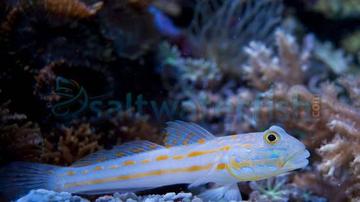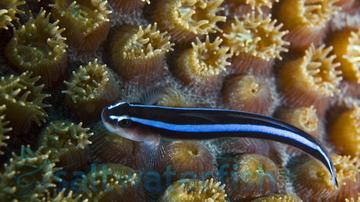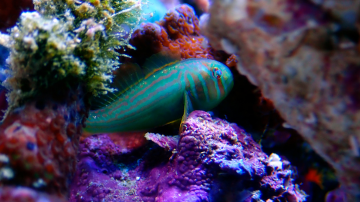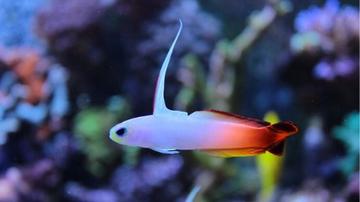Saltwater Aquarium Gobies: A Comprehensive Guide
Saltwater aquarium gobies are incredibly diverse and stunning species that add color and life to any marine tank. These small, bottom-dwelling fish are known for their vibrant coloration and unique behaviors, making them a popular choice among aquarium enthusiasts. This article offers an in-depth look at these fascinating creatures, their importance in the marine ecosystem, and how to care for them in a home aquarium.
Gobies Overview
Gobies are a group of small fish species that belong to the family Gobiidae. They are one of the largest fish families with more than 2,000 species in more than 200 genera. Often brightly colored, saltwater aquarium gobies are known for their burrowing behaviors and are found in nearly all marine environments. They play a crucial role in the marine ecosystem by consuming algae and detritus, and some species also serve as cleaner fish.
These fish are an excellent addition to any saltwater aquarium due to their peaceful nature and small size. They have a unique ability to adapt to various habitats and can live harmoniously with a variety of tank mates. Their intriguing behaviors and attractive appearance make them a favorite among aquarists.
Top 4 Saltwater Aquarium Gobies
There are several types of gobies that are well-suited for saltwater aquariums. Some of the most popular include the Diamond Goby, War Paint Clown Goby, Firefish Goby, and the Neon Cleaner Goby.
-
Diamond Gobies (Valenciennea puellaris): These are one of the most popular species of gobies for saltwater aquariums. They are known for their striking appearance, with a white body covered in bright orange spots that resemble diamonds, hence the name. Diamond Gobies are also known as sand sifters, as they have a unique behavior of sifting through the sand in search of food. They can grow up to 6 inches in length and are generally peaceful, making them a great addition to most aquariums.
-
War Paint Clown Gobies (Gobiodon histrio): These gobies are small, typically reaching only about 1.5 to 2 inches in length. They are known for their vibrant coloration, with a green body and red or orange markings around the mouth and eyes, which resemble war paint. They are a peaceful species and are known to form symbiotic relationships with certain types of coral.
-
Firefish Gobies (Nemateleotris magnifica): Also known as the Fire Dartfish, these gobies are known for their bright colors and elongated dorsal fin. They have a yellow head, a white body, and a red-orange tail, which gives them their fiery name. Firefish Gobies are timid and peaceful, preferring to hide in rock crevices. They can grow up to 3 inches in length.
-
Neon Cleaner Gobies (Elacatinus oceanops): These gobies are small, usually only reaching about 2 inches in length. They are known for their bright neon blue stripes that run along their bodies. Neon Cleaner Gobies are known as "cleaner" gobies because they eat parasites off of other fish, providing a cleaning service. They are peaceful and can coexist with a variety of other species.
Over 50 Saltwater Aquarium Gobies for sale available at saltwaterfish.com
Remember, all these species have different care requirements and compatibility with other species, so it's important to research thoroughly before adding them to your aquarium.
Care and Maintenance of Saltwater Aquarium Gobies
Ideal Tank Conditions:
Gobies are generally hardy and adaptable fish, but it's essential to provide them with the right tank conditions to ensure their well-being. Here are some key considerations:
-
Tank Size: The minimum tank size for most gobies is around 20 gallons, although larger tanks are recommended for species that grow larger or if you plan to keep multiple gobies. A larger tank provides more swimming space and helps maintain stable water parameters.
-
Water Parameters: Gobies thrive in saltwater with specific water parameters. The ideal temperature range is typically between 75°F and 82°F (24°C to 28°C). Salinity levels should be maintained between 1.020 and 1.025 specific gravity. Ammonia, nitrite, and nitrate levels should be kept at zero, and pH should range from 8.1 to 8.4.
-
Substrate and Decor: Gobies appreciate a sandy substrate in the aquarium, as it allows them to sift through it in search of food and provides a natural environment. Providing hiding spots like live rock or caves is important to create territories and reduce stress.
-
Lighting: While gobies do not have specific lighting requirements, a moderate lighting setup with a natural day-night cycle is usually sufficient. Ensure that the lighting isn't too intense, as some species prefer dimly lit environments.
Feeding and Diet:
Gobies have diverse feeding habits, and their diet can vary depending on the species. Here are some general guidelines for feeding and diet:
-
Omnivorous Gobies: Many gobies are omnivorous and consume a mix of meaty and plant-based foods. They readily accept a variety of frozen and live foods such as brine shrimp, mysis shrimp, copepods, and finely chopped seafood. Supplement their diet with high-quality pellet or flake foods specifically designed for marine fish.
-
Herbivorous Gobies: Some gobies, like the various species of algae gobies, are herbivorous and require a diet primarily composed of marine algae. You can offer them dried seaweed or marine algae-based pellets specifically made for herbivores.
-
Feeding Frequency: Feed small amounts of food multiple times a day rather than a single large feeding. This replicates their natural feeding behavior and prevents overfeeding, which can lead to water quality issues.
Health and Disease Prevention:
Maintaining good health and preventing diseases in gobies involves various factors. Here are some important considerations:
-
Water Quality: Consistently monitor and maintain water quality parameters within the recommended range. Perform regular water changes to keep the nitrate levels low and ensure good oxygenation. Use a quality protein skimmer to remove organic waste.
-
Quarantine: Whenever introducing new gobies or any other fish to the aquarium, it's crucial to quarantine them first. This helps prevent the introduction of parasites or diseases into the main tank.
-
Compatibility: Gobies can be territorial, so it's essential to consider their compatibility with other tank mates. Avoid aggressive or large fish species that may intimidate or harm the gobies.
-
Observation: Regularly observe your gobies for any signs of stress, disease, or abnormal behavior. Common signs of health issues include loss of appetite, color fading, rapid breathing, or visible lesions. If you notice any problems, take appropriate action promptly.
-
Professional Advice: If you suspect or identify a health issue, consult with a knowledgeable aquarium professional or a veterinarian experienced in fish care. They can provide accurate diagnoses and recommend appropriate treatments.
Remember, specific goby species may have additional care requirements, so always research the particular species you intend to keep.
Yasha Goby for sale @ Saltwaterfish.com. Candy Stripe (Randalli) Pistol Shrimp for sale @ Saltwaterfish.com
Saltwater Aquarium Gobies Social Behavior and Compatibility with Other Species
Saltwater aquarium gobies exhibit various social behaviors and have different levels of compatibility with other species. Here are some important points to consider:
-
Territoriality: Gobies are generally territorial fish, especially when it comes to defending their burrows or hiding spots. They may become aggressive towards other gobies or fish that encroach upon their territory. It's important to provide ample hiding places and territories for each goby if you plan to keep multiple individuals.
-
Pair Bonding: Some gobies, such as the popular clown gobies (Gobiodon species), form monogamous pairs. These pairs exhibit interesting behaviors like cooperative spawning, sharing of burrows, and defending their territory together.
-
Aggression and Compatibility: While gobies are generally peaceful, they may display aggression towards other fish, particularly those with similar body shapes or patterns that could be mistaken for intruding gobies. It's crucial to research the specific goby species you plan to keep to ensure compatibility with other tank mates.
-
Cleaning Behavior: Some gobies, like the cleaner gobies (Elacatinus spp.), have a fascinating symbiotic relationship with other fish. They act as cleaner fish by removing parasites and dead skin from the bodies of larger fish. These gobies set up cleaning stations where they perform this vital cleaning service, and other fish visit them to get cleaned.
Unique Traits and Abilities of Saltwater Aquarium Gobies
Saltwater aquarium gobies possess several unique traits and abilities that make them captivating additions to marine tanks. Here are a few notable examples:
-
Sand Sifting: Many gobies have specialized mouth structures that allow them to sift through sand or substrate in search of food. They ingest mouthfuls of sand, extract edible particles such as small invertebrates or organic matter, and expel the remaining sand. This behavior helps to keep the substrate clean and promotes a healthy aquarium ecosystem.
-
Burrowers: Numerous gobies are known for their burrowing behavior. They create and inhabit burrows within the substrate, using their bodies and pectoral fins to dig and shape their homes. These burrows provide security and shelter for the gobies and can add an interesting dynamic to the aquarium's layout.
-
Jumping Ability: Some gobies have a remarkable ability to jump out of open aquariums. It's crucial to have a tightly fitted lid or mesh covering to prevent escapes. Failure to secure the tank can result in injury or death for these agile jumpers.
-
Mimicry: Certain species of gobies possess incredible mimicry abilities. For example, the Ambon or Psychedelic mandarinfish (Synchiropus splendidus) imitates the coloration of a toxic flatworm to deter predators. This unique adaptation showcases the gobies' ability to mimic other organisms and offers protection in the wild.
Remember, the specific behavior and traits of gobies can vary depending on the species. It's essential to research the specific goby species you're interested in to understand their compatibility, care requirements, and any special behaviors they may exhibit.








